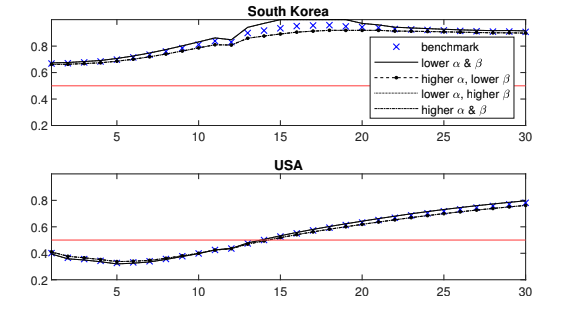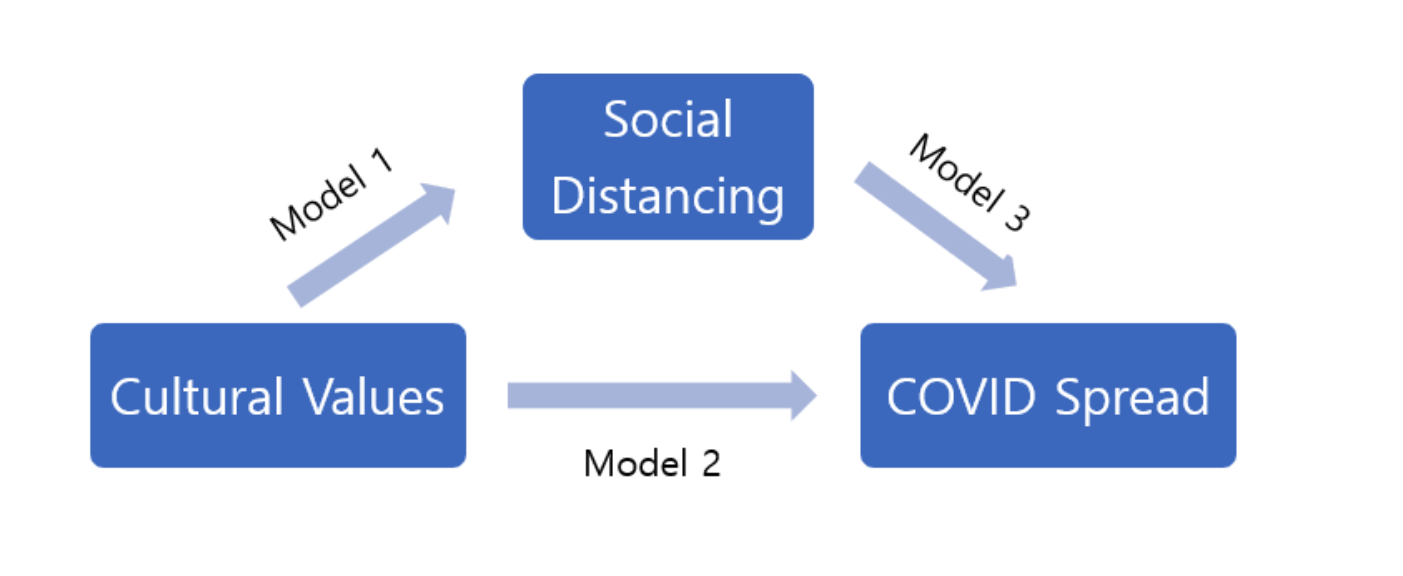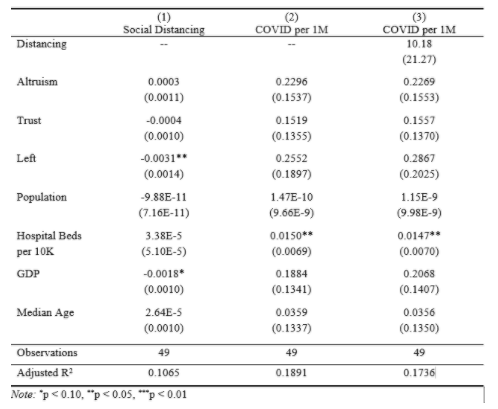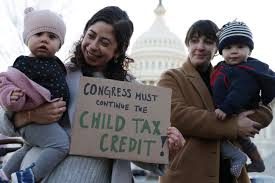
GRACE JANG – OCTOBER 27TH, 2020
EDITOR: ABHISHEK ROY
Background
Since the first outbreak of COVID-19 in Wuhan, China, the pandemic has reached and spread across other countries at different speeds. Some countries like South Korea and Germany have fared better than others, suffering lower transmission and mortality rates and smaller economic downturn. In popular opinion, these countries’ success stories are commonly attributed to the government’s actions such as strict enforcement of social distancing measures, introduction of contact tracing programs, and the presence of a robust public healthcare system. However, there is a growing body of literature that links cultural variables like altruistic beliefs and generalized trust with national performance during the pandemic. Building on these studies, we examine the role of national cultural values in the society’s adherence to social distancing measures and their effect on COVID-19 infection rates. Specifically, we investigate whether the practice of social distancing mediates the relation between cultural biases and the spread of COVID-19 when controlling for various possible confounds.
Method
Our initial sample is the top 80 countries by confirmed COVID-19 case counts as of October 1st. As a measure of the spread of COVID-19, we use the total number of COVID-19 cases per 1 million inhabitants. For social distancing, we use the Model-Inferred Distancing (MIDIS) data, developed by M. Aykut Attar and Ayça Tekin-Koru, to identify average physical distancing on the first day after the 500th case has been confirmed in that country. MIDIS is a model-based measure of unobserved distancing across countries and time, and its validity is supported by its strong correlation with Google and Apple mobility indicators. As shown in Figure 1 below, the Chinese case is used as the benchmark for the MIDIS data, so the day-1 MIDIS values are normalized relative to China’s value of 0.5. As Figure 2 illustrates, South Korea and the USA have the highest and lowest 30-day average MIDIS values among the sample countries, respectively. Since South Korea is well-known for its low transmission rate and the USA for its high transmission rate, these examples seem to add plausibility to the theory that social distancing is associated with less severe spread of the virus.
Figure 1. MIDIS: Summary Statistics

Image source: The MIDIS Project
Figure 2. MIDIS: South Korea and the USA

Image source: The MIDIS Project
Next, for cultural variables, we use the World Values Survey data aggregated by the Association of Religion Data Archives and take the average of the Wave 3 and Wave 4 values, which span the years 1995 to 2004. Specifically, we focus on altruistic beliefs, generalized trust, and political leaning because individuals who care about the utilities of others and trust that others comply with social distancing may be more likely to partake in the communal efforts for minimizing the COVID-19 transmission through the practice of social distancing. The variable Altruism is the percentage of respondents who chose ‘unselfishness’ among important child qualities; Trust is the percentage who answered ‘yes’ to the question whether they trusted most people; and Left is the percentage who placed themselves to the left on the political spectrum. In addition, we control for the country’s total population as of October 1st, number of hospital beds per 10,000 population in the year 2015, Purchasing Power Parity (PPP) GDP in international dollars in the year 2019, and median age in the year 2020. After dropping countries with missing data, our sample size is reduced to 49 countries.
To measure the mediation effect of social distancing on the association between culture and COVID-19 case counts, we conduct three OLS regressions:
Model 1.
MIDIS = β0 + β1 * Altruism + β2 * Trust + β3 * Left + β4 * Population + β5 * Hospital Beds + β6 * GDP + β7 * Age + ε
Model 2.
COVID = β0 + β1 * Altruism + β2 * Trust + β3 * Left + β4 * Population + β5 * Hospital Beds + β6 * GDP + β7 * Age + ε
Model 3.
COVID = β0 + β1 * MIDIS + β2 * Altruism + β3 * Trust + β4 * Left + β5 * Population + β6 * Hospital Beds + β7 * GDP + β8 * Age + ε
We adopt the mediation analysis suggested by Baron & Kenny (1986) consisting of three sets of regression: X → M, X → Y, and X + M → Y. In our study, the three sets of regression can be expressed as: Culture → MIDIS, Culture → COVID, and Culture + MIDIS → COVID. If a mediation effect exists, the effect of the cultural variables on COVID will weaken when the mediator MIDIS is included in the regression. In other words, the coefficient estimates for the cultural variables in Model 3 will be smaller than in Model 2. If so, this would signify that social distancing is a mechanism by which cultural values affect the COVID-19 spread.
Figure 3. Mediation Analysis

Results
Figure 4. Regression Results

In Model 1, the coefficient estimates on Left and GDP are statistically significant. Specifically, as the proportion of left-leaning inhabitants increases by 1%, MIDIS decreases by 0.0031, and as GDP increases by 1 international dollar (PPP), MIDIS decreases by 0.0018. Simply put, countries that have a larger proportion of left-leaning inhabitants and higher GDP tend to have lower average social distancing.
In Models 2 and 3, only Hospital Beds has a statistically significant coefficient. As hospital bed count per 10,000 inhabitants increases by 1 bed, COVID-19 case count per 1 million inhabitants increases by 0.015 case when excluding MIDIS from the regression and increases by 0.0147 case when including MIDIS in the regression. Thus, regardless of whether social distancing is included or excluded, countries that have more hospital beds per capita tend to have more COVID-19 cases per capita. Furthermore, coefficient estimates in Model 3 do not seem much smaller in their magnitude than those in Model 2, suggesting that social distancing has no meaningful mediating effect on the correlation between the independent variables and COVID-19 case count per capita.
Discussion
Of the three cultural variables, only political leaning has a statistically significant association with social distancing. Of the control variables, GDP is negatively correlated with social distancing, and hospital bed count per capita is positively correlated with the COVID-19 spread.
Our results can be interpreted in three ways. The first scenario is that all three models are specified correctly. This would imply that societies that are more left-biased and wealthier practice less social distancing than other societies. There may exist multiple reasons for this, but one possible explanation is that liberal individuals tend to value personal autonomy more than conservatives do, so they may be more predisposed to freely engage in their daily activities rather than strictly adhere to social distancing rules. In addition, individuals in wealthier societies may have more complex social relations and daily lifestyles than those in less developed societies, so they may find it harder to abruptly discontinue their normal activities and interactions in the face of the pandemic.
The first scenario also necessarily means that countries with more hospital beds per capita have wider COVID-19 spread. Perhaps this is because people are less careful with minimizing transmission when they have a better healthcare system available, leading to a higher COVID-19 infection rate but also better treatment and recovery rates. Another plausible explanation is that countries with a better healthcare system may test for COVID-19 cases more rigorously, resulting in a greater number of confirmed COVID-19 cases. Furthermore, under the first scenario, neither altruism nor generalized trust has explanatory power for social distancing or for the COVID-19 spread, and social distancing does not link the cultural and control variables with the COVID-19 spread.
Secondly, the models could be mis-specified and suffer omitted-variable bias. To capture the true relationship among culture, social distancing, and the COVID-19 spread, more cultural variables like attitude towards hygiene and communal embeddedness, as well as control variables like government policies, would need to be included in the regression.
Lastly, it is also probable that the limitation in data collection has diminished the accuracy of our models. Our small sample size is highly likely to have inflated standard errors, and the outdated World Values Survey data probably resulted in inaccurate values for our cultural variables.
Conclusion
Our analysis suggests that countries with more left-leaning inhabitants and higher GDP tend to practice less social distancing; countries with more hospital beds per capita are likely to have more COVID-19 cases per capita; and social distancing may not mediate the effect of cultural biases on the pandemic’s spread. However, our models may not accurately reflect the reality in that they utilize partly outdated data and omit important cultural and control variables such as attitude towards hygiene and government actions. Therefore, through more recent and relevant data, future studies can draw better insight into the relationship between cultural values, social distancing, and the COVID-19 spread.
Despite the weak evidence, our models lend support to the possibility that social distancing might not depend significantly on the cultural values of a country. Such possibility has not only a descriptive but also a normative implication. Indeed, in these times of difficulty, we must all act with the same values of consideration for each other’s well-being and trust in those around us in order to overcome the crisis collectively and effectively.
Featured Image Source: Time
Disclaimer: The views published in this journal are those of the individual authors or speakers and do not necessarily reflect the position or policy of Berkeley Economic Review staff, the Undergraduate Economics Association, the UC Berkeley Economics Department and faculty, or the University of California, Berkeley in general.



